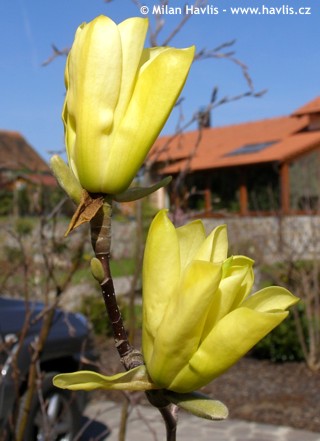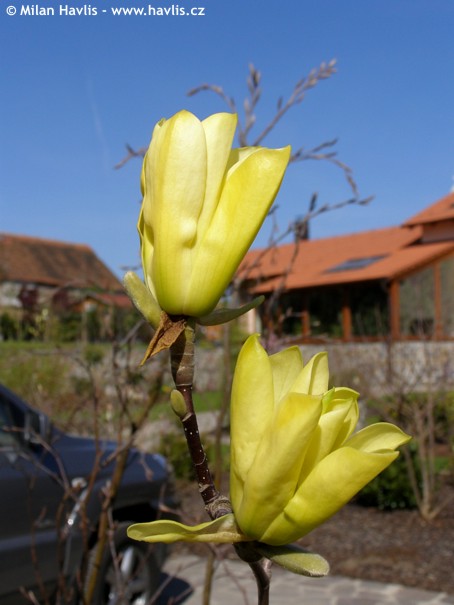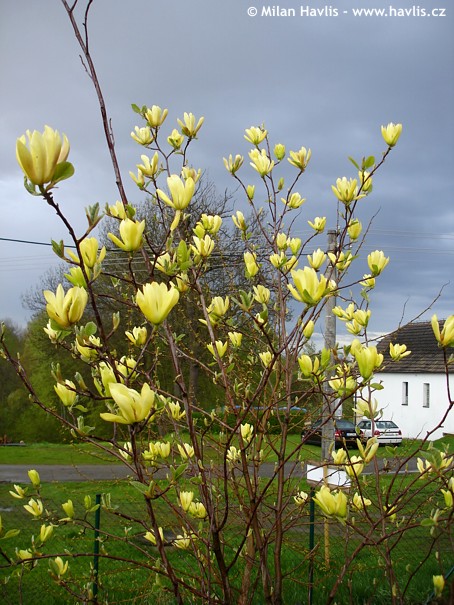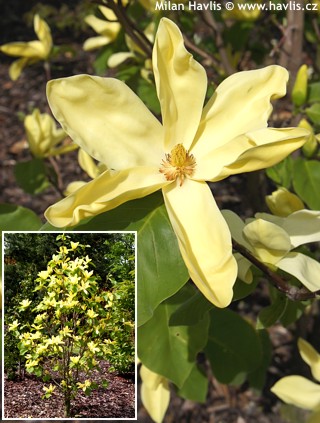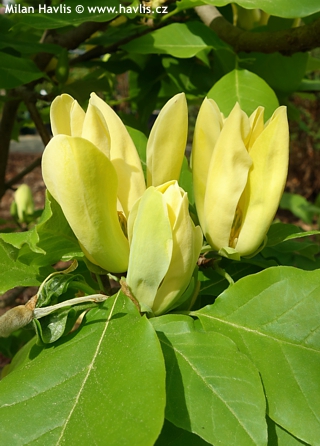Magnolia 'BUTTERFLIES' magnolia


So far, we have not experienced any significant fading of the flower during hot spring days, as the English complain. It is a very pleasant yellow, sometimes with a slight greenish tint at the base of the outer sepals. The flower is not large, and its shape is somewhere between a tulip and a star magnolia. This magnolia blooms at a very early age, sometimes in the first year after grafting. And since it blooms mid-late, it avoids late spring frosts. It blooms before the leaves emerge, reliably, and more abundantly each year.
The leaves are quite large, obovate, velvety matte, fresh green from spring to autumn, and their abundance makes the shrub look very dense. It forms a medium-wide shrub with a height and width of around 3 meters (10 feet) in gardens and 5 meters (16 feet) in parks with unlimited root space. In warmer climates, it makes longer annual growths, and the overall size in maturity is reported to be up to 2 meters (6.5 feet) more. However, it is desirable for it to grow at its natural pace, as it can then produce a flower bud at the tip of each new twig.
Magnolias are not supposed to be pruned. You can prune old shrubs if ill, or trim them to shape or to reduce size, or make an elementary cut to young plants of unsightly or unhealthy appearance. Do this as soon as possible after flowering to secure setting of flower buds for the following year. Be aware that each magnolia can respond differently to pruning.
Deciduous magnolias are quite easy plants. All they need is light, well-drained, acidic soil with equal moisture throughout the year. Once established they can do with occasional drought but will not look as nice as the ones with regular watering. Just pay attention to how to plant your magnolia. First, find it a spot where it will live forever and ever. It does not like transplanting. And as it makes shallow roots reaching well over its spread stay away from disturbing the roots by digging or messing about around it. Just cover the soil with bark mulch and do not plant anything else near it after say the second year after planting onwards. You could damage the very important top roots that absorb maximum moisture and nutrients from the soil. Also avoid planting magnolia too deep. This way you could be digging its grave. It is very hardy withstanding temperatures even lower than -30 °C (possibly USDA zone 4), just make sure it is not in a too exposed windy area.
Last update 11-12-2007; 15-01-2025
Goods are shipped all over Europe. For Russia and U.K. and for further details please read about SHIPPING OPTIONS HERE.
Are you interested in a serious discount for orders NOV-FEB? Check your options here.
THE PRICES INCLUDE VAT of 15%. For quick conversion you can use 1 CZK = approx. 0.04 EUR
- STANDARD QUALITY - Plants of this group are 1st class quality with number of branches and overall density adequate to their size and age, considering they were container grown.
- DE LUXE QUALITY - This label guarantees a luxurious quality of manually selected plants that, compared to their height and age, are exceptionally dense and beautiful.
- EXTRA - These plants are usually mature and bigger specimens with exceptional overall appearance.
- STANDARD (as described in the plant form) means a tree with a trunk of 190-210 cm and a crown at the top, unless specified differently. The commercial size for trees is their girth measured in the height of 1m from ground.
- HOBBY - These plants are of the same quality as our standard-quality plants but younger and therefore cheaper.
- SHRUB - a woody plant with branches growing bushy from the ground level.
- HALF-STANDARD or MINI-STANDARD - a small tree with shorter trunk, its size is usually specified.
- FEATHERED - These are trees with branches growing already from the base of the trunk and up along the stem.
- GRASSES and PERENNIALS - Sizes given usually read the diameter of the pot or the clump, as specified.












